USS Winston S. Churchill
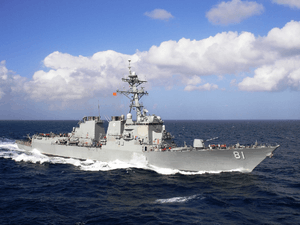 USS Winston S. Churchill | |
| History | |
|---|---|
| Name: | USS Winston S. Churchill |
| Namesake: | Winston S. Churchill |
| Ordered: | 6 January 1995 |
| Builder: | Bath Iron Works |
| Laid down: | 7 May 1998 |
| Launched: | 17 April 1999 |
| Commissioned: | 10 March 2001 |
| Motto: | "In war: Resolution; In peace: Good Will" |
| Status: | in active service |
| Badge: |
 |
| General characteristics | |
| Class and type: | Arleigh Burke-class destroyer |
| Displacement: | 9,200 tons (9,350 t) |
| Length: | 509.5 ft (155.3 m) |
| Beam: | 66 ft (20 m) |
| Draft: | 31 ft (9.4 m) |
| Propulsion: | 4 × General Electric LM2500-30 gas turbines, 2 shafts, 100,000 shp (75 MW) |
| Speed: | exceeds 30 knots (56 km/h; 35 mph) |
| Complement: | 32 officers, 348 enlisted |
| Electronic warfare & decoys: | AN/SLQ-32(V)3 |
| Armament: |
|
| Aircraft carried: | 2 × SH-60 Sea Hawk helicopters |
USS Winston S. Churchill (DDG-81) is an Arleigh Burke-class destroyer of the United States Navy. She is named after British Prime Minister Winston S. Churchill. This ship is the 31st destroyer of its class. Winston Churchill was the 18th ship of this class to be built at Bath Iron Works in Bath, Maine, and construction began on 7 May 1998. She was launched and christened on 17 April 1999. On 10 March 2001, she was commissioned during a ceremony at Town Point Park in Norfolk, Virginia. Her home port is in Naval Station Norfolk, Virginia. She is a component of Carrier Strike Group Twelve.
Naming
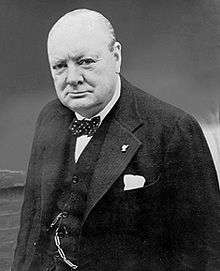
On 29 November 1995, on a visit to the United Kingdom, President Bill Clinton announced to both Houses of Parliament that the new ship would be named after former British Prime Minister and Honorary Citizen of the United States, Sir Winston Churchill. It would make it the first warship of the United States Navy to be named after a non-American citizen since 1975, and the first destroyer and only the fourth American warship named after a British citizen.
Other American warships named after Britons were Alfred, an armed merchantman named after King Alfred the Great; Raleigh, a continental frigate, named after Sir Walter Raleigh (though three later USS Raleighs—and two Confederate warships—would be named after the North Carolina city, which did not exist at the time) and Effingham, named after The 3rd Earl of Effingham who resigned his commission rather than fight the Americans during the American Revolutionary War. The former frigate Harold E. Holt was also named after a person from a country in the Commonwealth of Nations, Harold Holt, the Australian Prime Minister who is presumed to have drowned in 1967. However, this is the first ship to be named after a modern British hero, or British Prime Minister.
Design
The ship is the first of the Flight IIA variants fitted with the 62-caliber Mark 45 Mod 4 naval gun system. The guns' longer barrels allow more complete combustion of the propellant, reducing barrel flare and improving projectile velocity and firepower against ship and shore targets; additionally, the Mk 45 mod 4 uses a modified gun-house, designed to reduce its radar signature. Churchill is armed with Tomahawk, Standard and ASROC (VLA) missiles.[1]
The vessel additionally contains two hangars, not present in earlier destroyers; these can house Light Airborne Multi-Purpose System (LAMPS) Sikorsky SH-60B or MH-60R Seahawk helicopters. These LAMPS can be fitted with air-to-surface missiles for surface ship attacks, and torpedoes for submarine attacks.
The ship is also fitted with the AN/SPY-1D phased array radar - this represents a significant advancement in the detection capabilities of the Aegis weapon system and provides enhanced resistance to electronic countermeasures. The radar can guide more than one hundred missiles at once to targets as far as 600 nautical miles (1,100 km; 690 mi).
Service history
The contract to build Churchill was awarded to the Bath Iron Works Corporation on 6 January 1995, and the keel was laid down on 7 May 1998. Churchill was launched on 17 April 1999, delivered 13 October 2000, and commissioned 10 March 2001. The launch and christening of the ship was co-sponsored by Lady Soames, the daughter of Winston Churchill, and Mrs. Janet Cohen, wife of the Secretary of Defense. Her first commanding officer was Commander (now Rear Admiral) Michael T. Franken.[2]
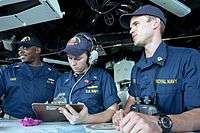
Churchill is the only U.S. Navy vessel to have a Royal Navy Officer permanently assigned to the ship's company (usually a Navigation Officer).[3] The U.S. Navy had a permanent U.S. Navy Officer on the Royal Navy ship, HMS Marlborough, until its decommission on 8 July 2005. Churchill is also the only U.S. Naval vessel to fly a foreign ensign. Being named after a Briton, the Royal Navy's White Ensign is honorarily flown on special occasions from the ship's mast, on the port side, whereas the American flag is flown from the starboard side.[4][5][6] However, during normal operations, only the US flag is flown on the center of the main mast.[7][8]
On 14 May 2001, Churchill underwent shock trials off the coast of Florida. These trials subjected the ship to several close-range underwater detonations, each consisting of 7 tons of high explosives, and were performed to collect data concerning ship survivability and damage resistance in a modern threat environment. Churchill sustained minor damage during these three tests.[9] On 14 September 2001, (three days after the 11 September 2001 attacks), the German Navy destroyer Lütjens passed close abeam Churchill and rendered honors by manning the rails, flying the Stars and Stripes at half-mast, and the display of a banner reading "We Stand By You." An e-mail sent by an ensign on board Churchill described the occasion.[10][11]
In January 2003, Churchill deployed with the USS Theodore Roosevelt battle group in support of the Iraq War's Operation Iraqi Freedom, firing several Tomahawk missiles. Churchill returned to Norfolk at the end of May 2003.
On 22 August 2005, Churchill was involved in a minor collision with the destroyer USS McFaul off the coast of Jacksonville, Florida. Both ships suffered minor damage, and no injuries were reported. Both ships returned to their homeport at Naval Station Norfolk under their own power.[12]
On 22 January 2006 Churchill captured a suspected pirate vessel in the Indian Ocean as part of an ongoing effort to help maintain law and order in the region.[13]
On 26 September 2010, Churchill came across a disabled skiff in the Gulf of Aden. After attempts to repair the skiff's engines failed Churchill took the vessel under tow towards Somalia. On 27 September the skiff sank when the 85 passengers rushed to one side of the skiff during a food delivery causing the vessel to capsize.[14] Churchill was able to rescue 61 of the passengers and continued towards Somalia on 28 September.[15]
Commanding officers
The Commanding Officer (CO) of USS Winston S. Churchill is the most senior officer that is in command of the ship. Sailors will refer to the CO as "the Captain" (regardless of rank), or sometimes informally as "Skipper". Below is the list of commanding officers of USS Winston S. Churchill.
| # | Name | Start | End |
|---|---|---|---|
| 11 | CDR Paul M. Allgeier | 8 September 2015 | Present |
| 10 | CDR Christine R. O'Connell | 28 February 2014 | 8 September 2015 |
| 9 | CDR Christopher D. Stone | 16 August 2012 | 28 February 2014 |
| 8 | CDR Michael E. Hutchens | 25 February 2011 | 16 August 2012 |
| 7 | CDR Juan J. Orozco | 21 August 2009 | 25 February 2011 |
| 6 | CDR Fred I. Pyle | 17 January 2008 | 21 August 2009 |
| 5 | CDR Mark J. Oberley | 1 November 2007 | 17 January 2008 |
| 4 | CDR Nelson C. Castro | 1 March 2006 | 1 November 2007 |
| 3 | CDR Todd W. Leavitt | 6 February 2004 | 1 March 2006 |
| 2 | CDR Holly A. Graf | 19 April 2002 | 6 February 2004 |
| 1 | CDR Michael T. Franken | 10 March 2001 | 19 April 2002 |
Coat of Arms
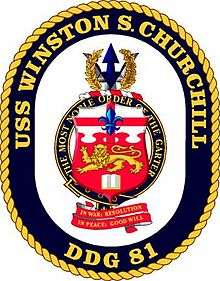
Shield
The shield features an inescutcheon of his ancestral coat of arms and the cross of St. George.
The traditional Navy colors were chosen for the shield because dark blue and gold represents the sea and excellence respectively. Red signifies sacrifice and valor. The cross of St. George and the fleur-de-lis are from Churchill’s augmentation from his ancestor’s coat of arms. The red cross on the white field is a reference to the flag of St. George. The gold lion over the field of red is a reference to the heritage of Great Britain. The lion shows strength, courage and determination. The nebuly is representative to the sky and clouds, which recall Britain enduring German airpower in the Battle of Britain. Winston Churchill’s reputation of an inspiring war leader, talented statesman, orator and author is referred to by the stylized book.
Crest
The crest consists of a trident encompassed by a chevron, laurel and oak.
The trident is a symbol for sea prowess and represents the ship’s vertical launch capabilities. The tridents tines denote air, surface, and anti-submarine warfare capabilities. A chevron divides the trident which suggests a “V” to signify victory in way and strength of defense in peace. The laurel symbolizes honor and achievement while the oak represents strength and resolve.
Motto
The motto is written on a double scroll of red that has a white reverse side.
The ships motto is "In war: Resolution" and "In peace: Good Will".
Seal
The coat of arms in full color as in the blazon, upon a white background enclosed within a dark blue oval border edged on the outside with a gold rope and bearing the inscription "USS Winston Churchill" at the top and "DDG 81" in the base all gold.
Gallery
 USS Winston S. Churchill returns to Naval Station Norfolk following a collision with USS McFaul
USS Winston S. Churchill returns to Naval Station Norfolk following a collision with USS McFaul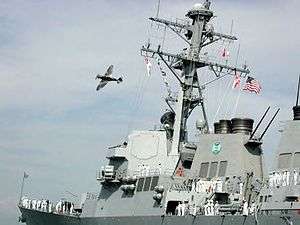 USS Winston S. Churchill at the Portsmouth International Festival of the Sea in 2001 as an RAF Supermarine Spitfire flies past
USS Winston S. Churchill at the Portsmouth International Festival of the Sea in 2001 as an RAF Supermarine Spitfire flies past_Parade_of_Ships.jpg) USS San Jacinto, USS Oscar Austin and USS Winston S. Churchill, participate in the Parade of Ships into New York Harbor
USS San Jacinto, USS Oscar Austin and USS Winston S. Churchill, participate in the Parade of Ships into New York Harbor.jpg) USS Winston S. Churchill performing a breakaway manoeuver with HMS Manchester
USS Winston S. Churchill performing a breakaway manoeuver with HMS Manchester_high_speed_run.jpg) 13 September 2001 – USS Winston S. Churchill makes a high-speed run in the English Channel
13 September 2001 – USS Winston S. Churchill makes a high-speed run in the English Channel_English_Channel.jpg) USS Winston S. Churchill, English Channel
USS Winston S. Churchill, English Channel The guided missile destroyer USS Winston S. Churchill, assigned to the U.S. 5th Fleet, patrols the Persian Gulf
The guided missile destroyer USS Winston S. Churchill, assigned to the U.S. 5th Fleet, patrols the Persian Gulf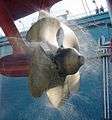 The shaft driver propeller under the port side stern
The shaft driver propeller under the port side stern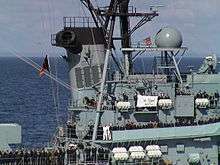 Lütjens: "We Stand By You". 14 September 2001
Lütjens: "We Stand By You". 14 September 2001 Churchill undergoes shock trials off the Florida coast.
Churchill undergoes shock trials off the Florida coast.
References
This article includes information collected from the Naval Vessel Register, which, as a U.S. government publication, is in the public domain.
- ↑ Kennedy, Harold (April 2001). "USS Churchill Shows Off High-Tech Gear". National Defense Magazine. Archived from the original on 27 September 2007. Retrieved 2 October 2015.
- ↑ "Vice Admiral Michael T. Franken, Deputy Commander for Military Operations U.S. Africa Command". US Navy. Retrieved 2 October 2015.
- ↑ Kennedy, Harold (April 2001). "USS Churchill Shows Off High-Tech Gear". National Defense. NDIA. Archived from the original on 27 September 2007. Retrieved 15 April 2007.
She also is the only U.S. Navy ship to have a British Royal Navy officer permanently assigned as a member of the ship’s company. Lieutenant Angus Essenhigh, RN, of Portsmouth, England, is serving as ship’s navigator during his two-year tour of duty.
- ↑ File:USS Churchill mast.jpg
- ↑ File:USS Winston_S. Churchill (DDG_81) English Channel.jpg
- ↑ File:USS Winston S. Churchill (DDG-81) high speed run.jpg
- ↑ File:Flickr - Official U.S. Navy Imagery - A VBSS team departs USS Winston S. Churchill..jpg
- ↑ File:010822-N-6967M-503 DDG 81 At Sea.jpg
- ↑ "DDG 81 Winston Churchill". GlobalSecurity.org. Retrieved 2 October 2015.
- ↑ United States Navy (2001). "This is an e-mail from an Ensign stationed aboard the ship during the UK deployment". Archived from the original on 29 December 2005. Retrieved 15 March 2006.
- ↑ File:LutjensHonors.jpg
- ↑ "USS MCFAUL (DDG 74) and USS WINSTON S. CHURCHILL (DDG 81) Collision". Damage Control Museum. Retrieved 5 March 2016.
- ↑ "Suspected Pirates Captured Off Somali Coast" (Press release). Headquarters, United States Central Command. 22 January 2006. Retrieved 15 December 2006.
- ↑ Mười ba thuyền nhân Phi Châu chết đuối (Vietnamese)
- ↑ "Tragic end to US rescue bid off Somali coast". BBC News. 28 September 2010.
Further reading
- International Festival of the Sea Official Souvenir Programme ( 24–27 August 2001)
- US Navy Press Release: USS Winston S. Churchill Intercepts Pirate Ship
External links
| Wikimedia Commons has media related to USS Winston S. Churchill (DDG-81). |